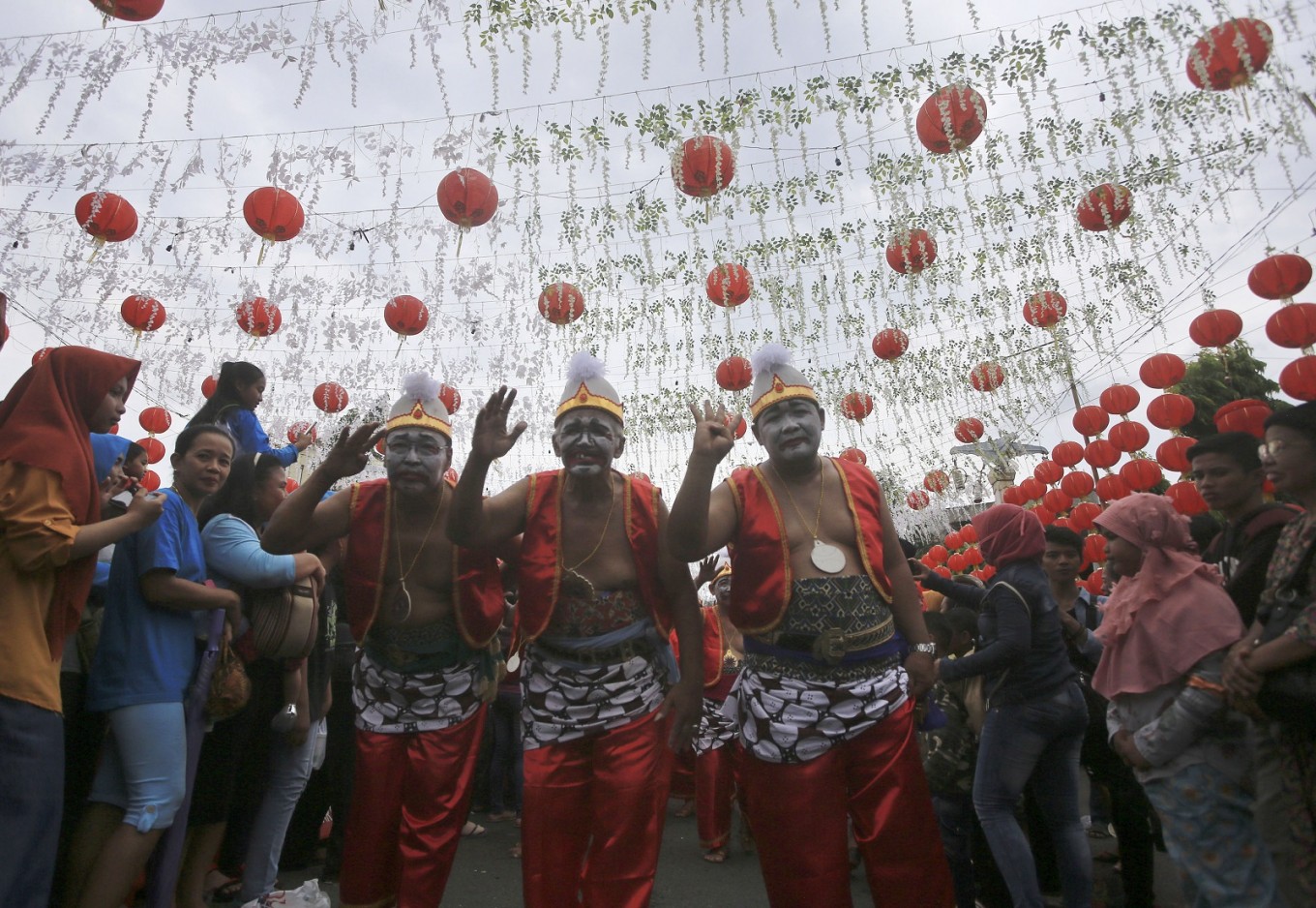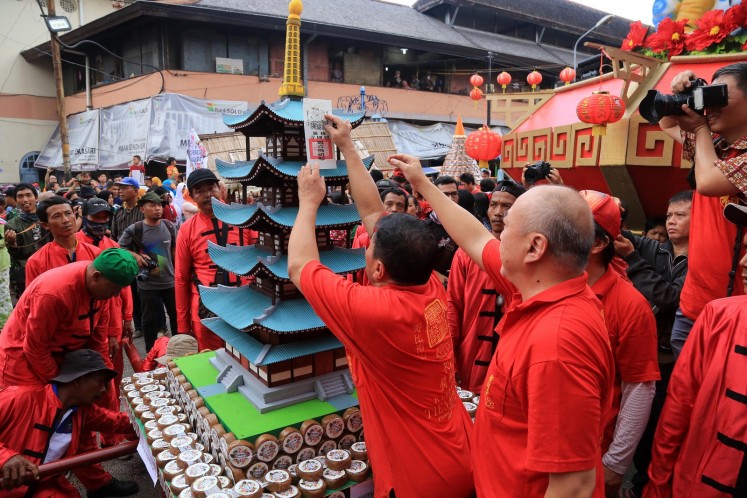Popular Reads
Top Results
Can't find what you're looking for?
View all search resultsPopular Reads
Top Results
Can't find what you're looking for?
View all search resultsA mash of Chinese New Year, cultural diversity in Surakarta
The Central Java town demonstrates tolerance and decades-long tradition of different ethnicities living side by side.
Change text size
Gift Premium Articles
to Anyone
T
he cultural carnival Grebeg Sudiro took place in the Pasar Gede area of Surakarta, Central Java, last Sunday. Gearing up for the Chinese New Year celebration, the crowd held up mountains of kue keranjang (nian gao or Chinese New Year’s cake, prepared from glutinous rice) while encircling Sudiroprajan village and ending right in front of Pasar Gede.
Sudiroprajan village is considered the Chinatown of Surakarta, covering the area of Pasar Gede, Tien Kok Sie Temple and a number of villages such as Balong, Kepanjen, Sudiroprajan, Mijen, and Limolasan. In those villages, cultural assimilation and diversity have been ongoing for decades.
This blending of Javanese and Chinese cultures was on display in the carnival. As many as 1,500 people participated in the event starting at 3 p.m. demonstrating a number of traditional arts in the parade, like reog (traditional dance from Ponorogo), Javanese and Gunung dances and barongsai (Chinese lion dance).
Sticking prayer papers on 'kue keranjang' mounds to be prayed upon in Tien Kok Sie Temple, Pasar Gede, Surakarta. (JP/Ganug Nugroho Adi)
A group performed the lembu sura (a cow-headed man) dance and a theatrical act of Joko Tingkir (the story of a former king in Java ruling in the mid-1500s). Another was bedecked in the costumes of shadow puppet characters, as well as costumes depicting gods and goddesses, kings and queens and monks.
Also in the parade were nine mounds of produce and kue keranjang. Two of them were shaped as a miniature of the Banjarsari 1945 Monument Park, the mayor’s official house called Loji Gandrung, and a miniature of Pasar Gede.
Read also: Surakarta ready for month long chinese new year celebration
'Barongsai' (Chinese lion dance). (JP/Ganug Nugroho Adi)Other mounds were stacked with kue keranjang, meat buns and traditional snacks representing the two cultures: getuk (colorful squares made from cassava coated with grated coconuts and sugar), klepon (green balls of rice cake filled with liquid palm sugar and coated in grated coconut), onde-onde (Chinese pastry made from glutinous rice flour), roti gembukan (fried bread) and other products.
Before the parade, two mounds of kue keranjang were taken inside the temple to be prayed upon alongside the barongsai. As in the previous years, the carnival’s course circled the Chinatown area for 4 kilometers, starting from Pasar Gede, Jl. Jenderal Sudirman, Bundaran Gladag, Lodji Wetan, Jl. Kapten Mulyadi, Jl. RE Martadinata, Jl. Ir Juanda, to return to Pasar Gede.
Thousands of people standing around the Pasar Gede area showed their enthusiasm, coming from everywhere to witness the carnival. Along the roads where the parade passed by, the crowd observed every attraction on display, such as barongsai performed by Chinese-Indonesian and Javanese dancers.
“Grebeg Sudiro diminishes differences. Now is no longer the time to question places and origins. This is a time of diversity. We have to keep knitting diversity while upholding unity, and respecting one another,” said Surakarta Mayor FX Hadi “Rudy” Rudyatmo.
The pinnacle of the carnival was marked by sharing kue keranjang with the crowd, thrown from the second floor of Pasar Gede. Thousands of people rushed to grab 4,000 kue keranjang.
Read also: Grebeg maulud solo celebrating prophet muhammad's birthday
Hanoman (one of the characters in the Ramayana) parade through Pasar Gede in the Grebeg Sudiro 2018. (JP/Ganug Nugroho Adi)Fatimah Sari, 22, who lives in Surakarta claimed she always made the time to witness the Grebeg Sudiro carnival to see the many costumes and unique arts.
“In Surakarta Chinese New Year is celebrated by the Javanese, not only the Chinese. It’s wonderful to see the barongsai and reog simultaneously,” said Fatimah, who hails from Aceh.
According to Grebeg Sudiro 2018 committee head Bul Hartomo, the event was a representation of tolerance and cultural diversity living side by side in Surakarta, especially concerning the Javanese and Chinese cultures.
“The assimilation does not stop at culture, it also lives in every part of our lives such as traditions, arts, health services and the economy. Surakarta is fascinating,” said Hartomo.
The annual Grebeg Sudiro first began seven years ago. Long before that, the people of Sudiroprajan village were accustomed to Buk Teko, a tradition of produce-offering for gods held for decades to welcome Chinese New Year. This ritual eventually became Grebeg Sudiro.
“The Grebeg Sudiro parade is aimed at uniting our country in diversity. In Sudiroprajan, people of Chinese and Javanese ethnicity live side by side. We would like to maintain this harmony,” said Sudiroprajan subdistrict head Daliman. (wen/kes)














